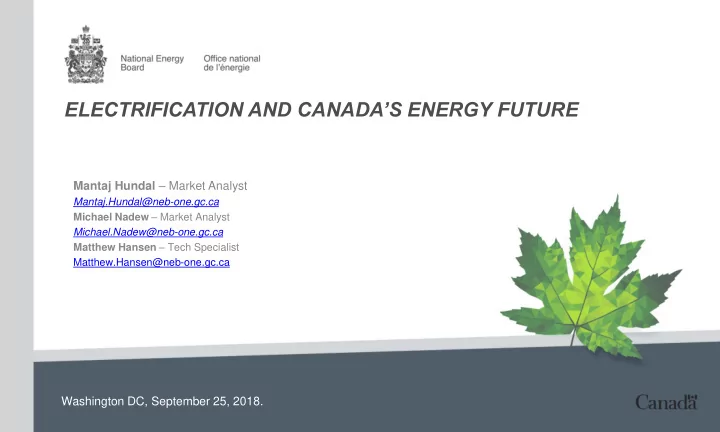

ELECTRIFICATION AND CANADA’S ENERGY FUTURE Mantaj Hundal – Market Analyst Mantaj.Hundal@neb-one.gc.ca Michael Nadew – Market Analyst Michael.Nadew@neb-one.gc.ca Matthew Hansen – Tech Specialist Matthew.Hansen@neb-one.gc.ca Washington DC, September 25, 2018.
National Energy Board and Energy Futures • The NEB’s Energy Futures (EF) is a series of reports that provide long-term energy supply and demand projections for Canada • Similar to the EIA’s Annual Energy Outlook • 2017 marked 50 years of NEB supply and demand outlooks 1
Energy Futures 2017 This presentation will focus on electricity results for 2 EF2017 scenarios: Reference Case • Currently announced policies • Consensus view prices, economic growth • Carbon price flat (nominal) post 2022 Technology Case • Greater adoption of select technologies (EVs, solar and wind power, heat pumps) • Rising carbon price • Lower crude oil price 2
NEB Modeling System • Main Model: ENERGY 2020, an integrated energy model creates the demand and electricity projections • Detail for all 13 provinces and territories • Four primary demand sectors: residential, commercial, industrial, transportation (all with detailed subsectors) • Electricity production defined for utility and industry across numerous technologies • The results discussed in this presentation are based on the 2017 Energy Futures Report. 3
Key Findings • Electricity will have key role in future energy transition. • In both demand and supply there are interesting regional differences. • There is potential for electrification in the residential and commercial sectors although this should be viewed in conjunction with improved efficiency. • Transportation sector electrification increases the sector’s electricity demand but its share remains less than 1% of total end-use demand. • The findings of this study show end-use electrification and power sector decarbonization contribute to limiting fossil fuel growth. 4
Over the past few years favorable policies and declining costs have spurred the deployment of renewables . In 2015 non-hydro renewables o accounted for 10% of total installed capacity, this more than doubles by 2040 in the Reference Case. In the Technology Case o installed capacity for solar and wind reach 25 GW and 31 GW respectively by 2040. 5
The shift towards wind, and solar causes Canada’s already low -emitting electricity sector to become even greener. By 2040, non-hydro renewables make up 30% of the supply mix. 6
Electricity Demand 2005 vs 2040 • In the Reference Case, electricity demand in the end-use sectors rise from 1 800 PJ in 2015 to 2 300 PJ in 2040. This growth is largely driven by end-use electrification in the residential, commercial and transportation sectors. 7
EV Adoption by Region Sales grow quickest in o Quebec because of the province’s EV mandate. By 2040, EVs account o for 34% of all passenger vehicles; total transportation energy demand in the Technology Case is 5% lower than the Reference Case. 8
Increased EV adoption boosts electricity demand, while impact of adding heat pumps for space and water heating varies by province. • Different technologies are used to heat homes and business. • In regions like Quebec, with a high share of baseboard heating systems, high penetration of heat pumps decreases electricity demand. • In contrast, the switch increases electricity demand in other provinces, such as Ontario, Alberta and British Columbia. 9
10
Recommend
More recommend